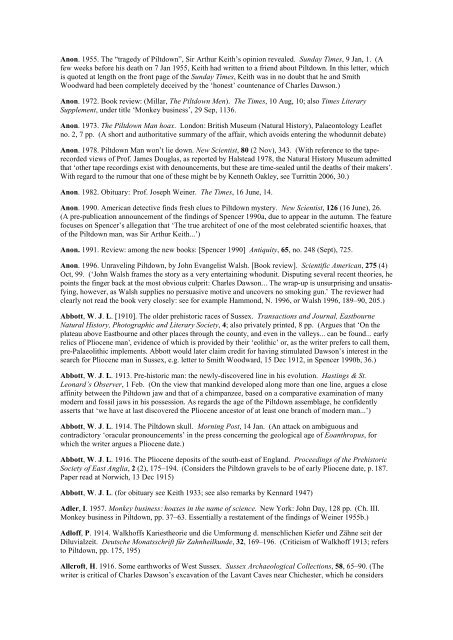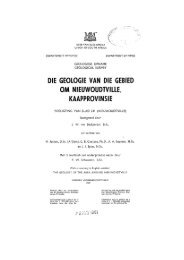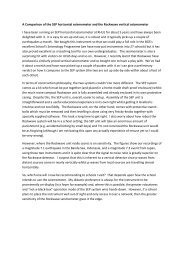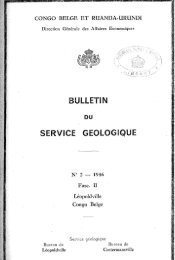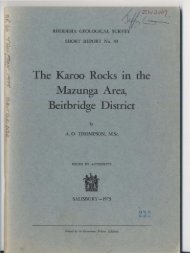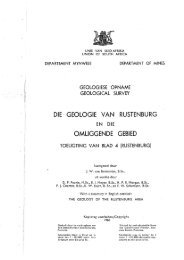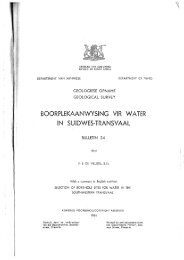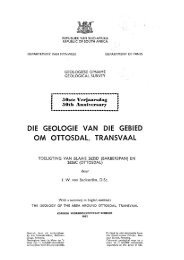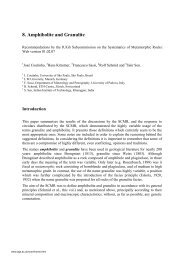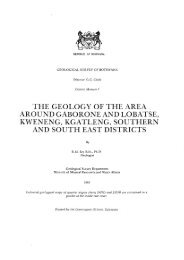Bibliography - British Geological Survey
Bibliography - British Geological Survey
Bibliography - British Geological Survey
You also want an ePaper? Increase the reach of your titles
YUMPU automatically turns print PDFs into web optimized ePapers that Google loves.
Anon. 1955. The “tragedy of Piltdown”, Sir Arthur Keith’s opinion revealed. Sunday Times, 9 Jan, 1. (A<br />
few weeks before his death on 7 Jan 1955, Keith had written to a friend about Piltdown. In this letter, which<br />
is quoted at length on the front page of the Sunday Times, Keith was in no doubt that he and Smith<br />
Woodward had been completely deceived by the ‘honest’ countenance of Charles Dawson.)<br />
Anon. 1972. Book review: (Millar, The Piltdown Men). The Times, 10 Aug, 10; also Times Literary<br />
Supplement, under title ‘Monkey business’, 29 Sep, 1136.<br />
Anon. 1973. The Piltdown Man hoax. London: <strong>British</strong> Museum (Natural History), Palaeontology Leaflet<br />
no. 2, 7 pp. (A short and authoritative summary of the affair, which avoids entering the whodunnit debate)<br />
Anon. 1978. Piltdown Man won’t lie down. New Scientist, 80 (2 Nov), 343. (With reference to the taperecorded<br />
views of Prof. James Douglas, as reported by Halstead 1978, the Natural History Museum admitted<br />
that ‘other tape recordings exist with denouncements, but these are time-sealed until the deaths of their makers’.<br />
With regard to the rumour that one of these might be by Kenneth Oakley, see Turrittin 2006, 30.)<br />
Anon. 1982. Obituary: Prof. Joseph Weiner. The Times, 16 June, 14.<br />
Anon. 1990. American detective finds fresh clues to Piltdown mystery. New Scientist, 126 (16 June), 26.<br />
(A pre-publication announcement of the findings of Spencer 1990a, due to appear in the autumn. The feature<br />
focuses on Spencer’s allegation that ‘The true architect of one of the most celebrated scientific hoaxes, that<br />
of the Piltdown man, was Sir Arthur Keith...’)<br />
Anon. 1991. Review: among the new books: [Spencer 1990] Antiquity, 65, no. 248 (Sept), 725.<br />
Anon. 1996. Unraveling Piltdown, by John Evangelist Walsh. [Book review]. Scientific American, 275 (4)<br />
Oct, 99. (‘John Walsh frames the story as a very entertaining whodunit. Disputing several recent theories, he<br />
points the finger back at the most obvious culprit: Charles Dawson... The wrap-up is unsurprising and unsatisfying,<br />
however, as Walsh supplies no persuasive motive and uncovers no smoking gun.’ The reviewer had<br />
clearly not read the book very closely: see for example Hammond, N. 1996, or Walsh 1996, 189–90, 205.)<br />
Abbott, W. J. L. [1910]. The older prehistoric races of Sussex. Transactions and Journal, Eastbourne<br />
Natural History, Photographic and Literary Society, 4; also privately printed, 8 pp. (Argues that ‘On the<br />
plateau above Eastbourne and other places through the county, and even in the valleys... can be found... early<br />
relics of Pliocene man’, evidence of which is provided by their ‘eolithic’ or, as the writer prefers to call them,<br />
pre-Palaeolithic implements. Abbott would later claim credit for having stimulated Dawson’s interest in the<br />
search for Pliocene man in Sussex, e.g. letter to Smith Woodward, 15 Dec 1912, in Spencer 1990b, 36.)<br />
Abbott, W. J. L. 1913. Pre-historic man: the newly-discovered line in his evolution. Hastings & St.<br />
Leonard’s Observer, 1 Feb. (On the view that mankind developed along more than one line, argues a close<br />
affinity between the Piltdown jaw and that of a chimpanzee, based on a comparative examination of many<br />
modern and fossil jaws in his possession. As regards the age of the Piltdown assemblage, he confidently<br />
asserts that ‘we have at last discovered the Pliocene ancestor of at least one branch of modern man...’)<br />
Abbott, W. J. L. 1914. The Piltdown skull. Morning Post, 14 Jan. (An attack on ambiguous and<br />
contradictory ‘oracular pronouncements’ in the press concerning the geological age of Eoanthropus, for<br />
which the writer argues a Pliocene date.)<br />
Abbott, W. J. L. 1916. The Pliocene deposits of the south-east of England. Proceedings of the Prehistoric<br />
Society of East Anglia, 2 (2), 175–194. (Considers the Piltdown gravels to be of early Pliocene date, p. 187.<br />
Paper read at Norwich, 13 Dec 1915)<br />
Abbott, W. J. L. (for obituary see Keith 1933; see also remarks by Kennard 1947)<br />
Adler, I. 1957. Monkey business: hoaxes in the name of science. New York: John Day, 128 pp. (Ch. III.<br />
Monkey business in Piltdown, pp. 37–63. Essentially a restatement of the findings of Weiner 1955b.)<br />
Adloff, P. 1914. Walkhoffs Kariestheorie und die Umformung d. menschlichen Kiefer und Zähne seit der<br />
Diluvialzeit. Deutsche Monatsschrift für Zahnheilkunde, 32, 169–196. (Criticism of Walkhoff 1913; refers<br />
to Piltdown, pp. 175, 195)<br />
Allcroft, H. 1916. Some earthworks of West Sussex. Sussex Archaeological Collections, 58, 65‒90. (The<br />
writer is critical of Charles Dawson’s excavation of the Lavant Caves near Chichester, which he considers


